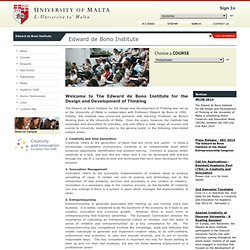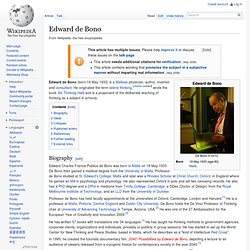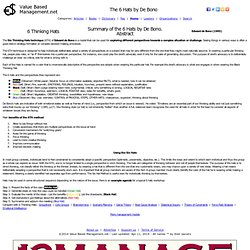

Edward de Bono The Full Interview. Edward de Bono, Professor, edwarddebono.com Like this video?

Then we'd love it if you wanted to: No comments on "Edward de Bono The Full Interview" We're very keen for you to share your comment on this hot topic, however we just ask that you become a member of LeadersIn first (and you'll be able to ask questions too), so click here to sign up (and share your wisdom with the world) today.
Edward de Bono on innovation vs creativity - how's it different. Edward de Bono, Professor, edwarddebono.com Like this video?

Then we'd love it if you wanted to: No comments on "Edward de Bono on innovation vs creativity - how's it different" We're very keen for you to share your comment on this hot topic, however we just ask that you become a member of LeadersIn first (and you'll be able to ask questions too), so click here to sign up (and share your wisdom with the world) today. EDWARD DE BONO'S AUTHORISED WEBSITE - HOME PAGE. The skill of thinking - Edward De Bono. De Bono for Business. Edward de Bono Institute - Edward de Bono Institute. The Edward de Bono Institute for the Design and Development of Thinking was set up at the University of Malta in collaboration with Professor Edward de Bono in 1992.

Initially, the Institute was concerned primarily with teaching Professor de Bono’s thinking tools at the University of Malta. Over the years, however, the Institute has expanded and diversified its activities, and now offers a wide range of courses and events to University students and to the general public in the following interrelated subject areas: 1. Creativity and Idea GenerationCreativity refers to the generation of ideas that are novel and useful. In today’s increasingly competitive environment, creativity is an indispensable asset which enhances opportunity identification and problem solving. 2. 3. 4. On behalf of my colleagues, I invite you to explore our Institute website to find out more about our courses, events, projects and research. Dr. The Edward de Bono Society. The de Bono Group - Six Thinking Hats.
Used with well-defined and explicit Return On Investment success in corporations worldwide, Six Thinking Hats is a simple, effective parallel thinking process that helps people be more productive, focused, and mindfully involved.

A powerful tool set, which once learned can be applied immediately! You and your team members can learn how to separate thinking into six clear functions and roles. Each thinking role is identified with a colored symbolic "thinking hat. " By mentally wearing and switching "hats," you can easily focus or redirect thoughts, the conversation, or the meeting. Edward de Bono Six Thinking Hats (1of2) Edward de Bono Six Thinking Hats (2of2) Six Thinking Hats Overview. The Six Thinking Hats. Six Thinking Hats. Six Thinking Hats is a book by Edward de Bono which describes a tool for group discussion and individual thinking involving six colored hats.

"Six Thinking Hats" and the associated idea parallel thinking provide a means for groups to plan thinking processes in a detailed and cohesive way, and in doing so to think together more effectively.[2] Underlying principles[edit] The premise of the method is that the human brain thinks in a number of distinct ways which can be deliberately challenged, and hence planned for use in a structured way allowing one to develop tactics for thinking about particular issues. de Bono identifies six distinct directions in which the brain can be challenged. In each of these directions the brain will identify and bring into conscious thought certain aspects of issues being considered (e.g. gut instinct, pessimistic judgement, neutral facts). 6 Thinking hats - Edward Debono. Six Thinking Hats.
Six Thinking Hats by Edward de Bono. Edward de Bono. Edward de Bono (born 19 May 1933) is a Maltese physician, author, inventor and consultant.

He originated the term lateral thinking,[citation needed] wrote the book Six Thinking Hats and is a proponent of the deliberate teaching of thinking as a subject in schools. Biography[edit] Professor de Bono has held faculty appointments at the universities of Oxford, Cambridge, London and Harvard.[1] He is a professor at Malta, Pretoria, Central England and Dublin City University. De Bono holds the Da Vinci Professor of Thinking chair at University of Advancing Technology in Tempe, Arizona, USA.[2] He was one of the 27 Ambassadors for the European Year of Creativity and Innovation 2009.[3] He has written 57 books with translations into 34 languages.[1] He has taught his thinking methods to government agencies, corporate clients, organizations and individuals, privately or publicly in group sessions.
Ideas[edit] Critiques[edit] In the Handbook of Creativity, Robert J. Published works[edit] 6 Thinking Hats - Edward de Bono. The Six Thinking Hats technique (6TH) of Edward de Bono is a model that can be used for exploring different perspectives towards a complex situation or challenge.

Seeing things in various ways is often a good idea in strategy formation or complex decision-making processes. De Bono Six Thinking Hats Summary Anne Egros. THE 7th HAT: for WISDOM and METACOGNITION. In a recent interview I was asked to add one more thinking hat to the original ’6 thinking caps’ developed by SOT in 1983.

I suggested the Seventh Hat for Wisdom, the Grey Thinking Hat. Survival is clever and requires intelligence. Long term survival endows broad experience and knowledge and is a very clever thing, indeed. It cannot be taught. The Grey Thinking Hat is for Wisdom. The experience of surviving for a complete generation through childhood, adolescence and adulthood endows knowledge and perspective that a young brain cannot match. To achieve 50 years of survival, through two or more generations, allows the brain to build a database of experience which offers a perspective of history, an understanding of long term consequences, a faculty for prediction and a wisdom that cannot be acquired in any other way.
(Master Vincent Van Gogh’s Self Portrait with Grey Hat, Paris, 1887) Edward de Bono CoRT Thinking Programme. EDWARD DE BONO - CoRT THINKING LESSONS. DR EDWARD DE BONO'S CoRT. CoRT Thinking Online - The Authorised Source for CoRT. Teach Thinking Today. School of Thinking. The School of Thinking (SOT) was founded by Michael Hewitt-Gleeson and Edward de Bono in New York, United States, in 1979 to teach 'thinking' as a skill.

Presently, SOT is a free, virtual school, based in Melbourne, Australia, that uses a daily series of free emailed lessons to teach speed thinking, creative thinking, positive thinking, lateral thinking, and new brain software which goes beyond 'critical thinking'. History[edit] SOT's initial mission was to get 'thinking' into schools as a school subject. Under Hewitt-Gleeson's direction, SOT instructors trained thousands of people around the United States, and installed thinking skills into school districts, corporations, and government organizations.
Within five years, 'teaching thinking' in US schools had become, according to the New York Times, the biggest new trend in education. Staff[edit] Co-Founder and Principal Michael Hewitt-Gleeson Vice Principal Eric M. Effective Thinking Skills Course - The Edward de Bono online course in Thinking. The Online de Bono Thinking Skills Course At last!

A distributed on-line learning course designed by Edward de Bono. The course is divided into three parts or modules that teach the powerful thinking tools and creativity techniques developed by Dr. de Bono. The aim of this course is to train people in thinking and to give them 'self esteem' in their ability to think. This leads to self confidence. "Thank you very much for this excellent course. Edward de Bono Thinking Course 1-3 Thinking is a Skill. Consider All Factors. In any situation, certain givens define the range of how we perceive it.
By expanding the scope of considerations with a conscious effort, we can increase the span of our attention to aspects that might have otherwise been missed. Consider All Factors (CAF) is an attention directing tool designed to do this. During a defined interval of time, you mentally list every consideration about a topic you can think of, as opposed to just the first few that come to mind.
An example A shy person is invited to a party. Body languageGreetingsResponse to questionsQuestions to ask othersDressing for impactFirst impressionsSmilingWho’s there that I already know? Some considerations arguably overlap: first impressions, dressing for impact, smiling. By consciously distributing cognition around a topic, he gives himself new things to think about.
Other examples We can “do a CAF” for a couple of minutes on just about any topic, either for better planning or simply for its own sake as a mental exercise. Lateral thinking. Lateral thinking is solving problems through an indirect and creative approach, using reasoning that is not immediately obvious and involving ideas that may not be obtainable by using only traditional step-by-step logic. The term was coined in 1967 by Edward de Bono. [1] According to de Bono, lateral thinking deliberately distances itself from standard perceptions of creativity as either "vertical" logic (the classic method for problem solving: working out the solution step-by-step from the given data) or "horizontal" imagination (having many ideas but being unconcerned with the detailed implementation of them). Methods[edit] Critical thinking is primarily concerned with judging the true value of statements and seeking errors.
Lateral thinking is more concerned with the "movement value" of statements and ideas. Random Entry Idea Generating Tool: The thinker chooses an object at random, or a noun from a dictionary, and associates it with the area they are thinking about. Po (lateral thinking) A "po" is an idea which moves thinking forward to a new place from where new ideas or solutions may be found. The term was created by Edward de Bono as part of a lateral thinking technique to suggest forward movement, that is, making a statement and seeing where it leads to. It is an extraction from words such as hypothesis, suppose, possible and poetry, all of which indicate forward movement and contain the syllable "po. " Po can be taken to refer to any of the following: provoking operation, provocative operation or provocation operation. Also, in ancient Polynesian and the Maori, the word "po" refers to the poporiginal chaotic state of formlessness, from which evolution occurred.
Edward de Bono argues that this context as well applies to the term. For example, Sales are dropping off because our product is perceived as old fashioned. Some of the above ideas may be impractical, not sensible, not business-minded, not politically correct, or just plain daft. Parallel thinking. Parallel thinking is a term coined and implemented by Edward de Bono.[1][2] Parallel thinking is described as a constructive alternative to "adversarial thinking", debate and in general the approach the GG3 (Greek gang of three) has been known to advocate.[3] In general parallel thinking is a further development of the well known lateral thinking processes, focusing even more on explorations—looking for what can be rather than for what is. Definition[edit] Parallel thinking is defined as a thinking process where focus is split in specific directions. When done in a group it effectively avoids the consequences of the adversarial approach (as used in courts).
In adversarial debate, the objective is to prove or disprove statements put forward by the parties (normally two). This is also known as the dialectic approach. Crucial to the method is that the process is done in a disciplined manner, and that all participants play along and contribute in parallel. Implementations[edit] See also[edit]